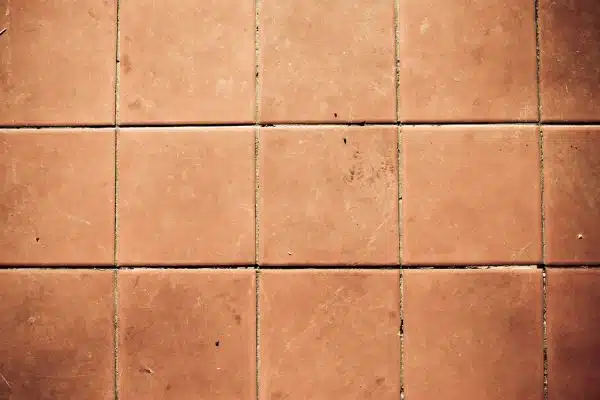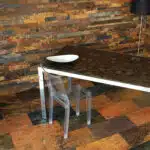As a tile installation expert, I have witnessed many homeowners struggle to complete one of the final tasks in their DIY tile project: grouting. Grouting may seem like a small detail, but it plays a crucial role in the overall aesthetic and durability of your tile floor. Properly grouting your tile floor can enhance its appearance, prevent moisture from seeping underneath, and protect the tiles from damage over time.
In this article, we will discuss the process of how to grout a tile floor. We will cover everything you need to know about selecting the right type of grout, preparing the surface for grouting, mixing and applying the grout, and finishing touches. By following these steps carefully, you can ensure that your tile floor looks beautiful and lasts for years to come. So let’s get started with our step-by-step guide on how to grout a tile floor!
Understanding The Importance Of Grouting
Installing a tile floor is akin to stitching together a beautiful tapestry with each tile serving as an individual thread. Grouting, then, becomes the vital seam that binds these threads together in a cohesive and functional whole. Understanding grout types and choosing the right color are crucial steps in ensuring your tile installation looks its best and stays structurally sound.
Grout is a mixture of cement, sand, and water used to fill gaps between tiles. There are two main types of grout: sanded and unsanded. Sanded grout is ideal for wider gaps between tiles, while unsanded grout is better suited for thinner gaps. When choosing which type of grout to use, consider the size of the gaps between your tiles.
Another important consideration when it comes to grouting is selecting the right color for your project. The color of your grout can have a significant impact on the overall look and feel of your tile installation. It’s essential to choose a color that complements the color of your tiles while also considering factors like ease of maintenance and durability. By understanding different grout types and colors, you’ll be well on your way to creating a tile floor that will stand the test of time.
Understanding grouting basics like selecting appropriate types and colors can make all the difference in achieving beautiful results for your tile installation project. However, before you begin applying any kind of grout, it’s essential first to assess if your tiled surface has been installed correctly or not.
Assessing Your Tile Installation
Before proceeding to grout your tile floor, it is important to assess the quality of the installation. Common mistakes during the installation process can lead to an improper installation that will compromise both the aesthetic appeal and durability of your tile floor. Signs of improper installation include uneven tiles, gaps between tiles, and cracked or loose tiles. These issues can cause tripping hazards and may require costly repairs down the line.
To avoid these problems, proper surface preparation is essential before laying your tiles. This includes ensuring that the subfloor is level and free from any debris or moisture. Any imperfections in the subfloor must be addressed with a quality leveling compound before proceeding with tile installation. Proper use of trowels and spacers during installation is equally crucial for achieving a level surface without gaps between tiles.
To assess your tile installation accurately, you will need a few tools on hand. A straight edge or level can help identify any high points or low spots in your tile floor, while a rubber mallet can be used to tap on each tile gently to check for any hollow sounds indicating poor bonding with the adhesive. By taking these steps before grouting your tile floor, you can ensure that you have a solid foundation for a durable and visually appealing finished product.
With an understanding of common mistakes and signs of improper installation, and knowing the importance of proper surface preparation and necessary tools for assessment, you are now ready to move on to choosing the right type of grout for your project.
Choosing The Right Type Of Grout
- When choosing the right type of grout for a tile floor installation, it is important to consider the two main options: epoxy grout and cementitious grout.
- Epoxy grout is a more expensive option, but is highly resistant to staining and chemical damage, making it a perfect choice for areas that are exposed to moisture and high traffic.
- Cementitious grout is a more affordable option, but is not as impervious to water and stains as epoxy grout.
- When it comes to grout color, there are many options available ranging from light to dark, and from neutral to bright colors to match the color of the tile.
Types Of Grout
When it comes to grouting a tile floor, choosing the right type of grout is crucial. Two main types of grout exist: sanded and unsanded. Sanded grout contains sand particles that provide stability and durability for larger gaps between tiles. On the other hand, unsanded grout is typically used for smaller gaps as it is smoother and easier to apply.
Another distinction in grout types is epoxy vs cementitious. Epoxy grout is made from two-part chemical compounds that create a hard, durable surface resistant to stains and water damage. This type of grout is ideal for high-traffic areas or spaces prone to moisture like bathrooms or kitchens. Cementitious grout, on the other hand, is made from cement powder mixed with water and can be either sanded or unsanded. While this type of grout may not be as durable as epoxy, it offers more flexibility in color options.
Ultimately, choosing the right type of grout depends on various factors such as tile size and location. Be sure to consult with a professional before making a decision. Remember that proper installation techniques and regular maintenance are also essential in ensuring a long-lasting tile floor. By understanding the differences between sanded vs unsanded and epoxy vs cementitious, you’ll be well on your way to selecting the perfect type of grout for your tile project.
Grout Color Options
When it comes to choosing the right type of grout for your tile project, there are various factors to consider. In addition to sanded vs unsanded and epoxy vs cementitious, another consideration is grout color options. Nowadays, grout color trends have expanded beyond traditional white or gray options and can have a significant impact on the overall look of your tile floor.
One important factor to keep in mind when selecting grout color is how it will complement or contrast with the tile color. Some homeowners prefer a seamless look where the grout blends in with the tile color, while others opt for a contrasting effect that highlights the individual tiles. Additionally, darker-colored grouts may be more prone to fading or staining over time.
It’s important to note that grout color can also affect how visible dirt and debris are on your tile floor. Lighter-colored grouts may show more dirt than darker ones, so if you’re someone who prefers low-maintenance cleaning, you may want to consider this factor as well. Ultimately, selecting the right grout color is a personal choice that depends on your aesthetic preferences and practical needs.
Gathering The Necessary Tools And Materials
Imagine you are a chef preparing to cook a gourmet meal. Before even beginning the cooking process, you must ensure that you have all the necessary tools and ingredients at your disposal. The same concept applies when grouting a tile floor. The success of your project relies heavily on proper preparation and organization of materials. Choosing tools and gathering materials is the first step towards achieving stunning results.
Choosing Tools:
- Grout float
- Sponge
- Bucket
- Grout saw
- Safety glasses
Gathering Materials:
- Grout
- Tile spacers
- Tile adhesive
- Sealant
- Water
When it comes to choosing tools for grouting, it is essential to select high-quality equipment that will help achieve clean and precise results. A grout float is a crucial tool that allows for even distribution of grout across the tiles’ surface. A sponge helps wipe away excess material while ensuring that the tiles remain clean throughout the process. A bucket is needed to mix and contain water and grout mixture, while safety glasses protect eyes from flying debris.
In addition to selecting appropriate tools, it is necessary to gather all required materials before starting your project. Grout, tile spacers, tile adhesive, sealant, and water are just some examples of items needed for successful completion of a tiling job. Ensuring that all these materials are at hand enables you to work efficiently without any unnecessary interruptions or delays.
With proper selection of tools and gathering of materials in place, you can now proceed with confidence towards preparing the surface for grouting. This step involves cleaning and prepping the tiles adequately before applying any grout material onto them – an important aspect which we shall discuss in detail in subsequent sections.
Preparing The Surface For Grouting
Surface Preparation is essential before applying the grout on a tile floor. The surface should be clean, dry and free from debris. It is recommended to clean the surface with a soft bristle brush or vacuum cleaner to remove any loose dust or debris from the surface. Cleaning Techniques differ for different types of surfaces, such as natural stone, ceramic, porcelain or glass tiles. Therefore, it is important to determine the type of tile before proceeding with cleaning.
After cleaning the surface, it is necessary to check if there are any cracks or chips on the tiles. If so, they should be repaired before proceeding with grouting. Repairing cracks and chips can be done using epoxy-based fillers or by replacing the damaged tiles. Once all repairs have been made and the surface has been thoroughly cleaned, it is recommended to apply a sealer to protect against staining and moisture penetration.
The Surface Preparation stage in Grouting Tile floors ensures that the final result looks flawless and lasts longer. A properly prepared surface will increase the durability of your tile floor as well as ensure that your grout adheres better over time. Taking care of this initial step will save you from future headaches caused by grout cracking or chipping due to poor preparation techniques.
Transition into next section: Now that we have covered Surface Preparation and Cleaning Techniques, let’s move on to Mixing The Grout for application onto your tile floor.
Mixing The Grout
After properly preparing the tile surface, it is time to mix the grout. The consistency of the grout plays a vital role in ensuring that it sets correctly and remains durable. Therefore, it is crucial to achieve the appropriate grout consistency before applying it to the tile floor.
To get the right grout consistency, start by adding water gradually to the dry grout mixture while continuously stirring. It is advisable to use a margin trowel or electric mixer for efficient mixing. Add small amounts of water until you achieve a smooth and thick paste without any lumps. Test its consistency by scooping some with a grout float and holding it upside down; if it sticks, then it’s perfect.
When mixing the grout, ensure that you follow specific techniques to avoid mistakes. For instance, avoid over-mixing as this can cause air bubbles in your mixture and affect its quality. Additionally, always mix enough grout that you can apply within 20-30 minutes before it starts to harden. This ensures that you don’t have any dried-up clumps on your tile floor as you work.
Now that you have achieved the correct grout consistency and mixed your paste using proper techniques, it’s time to apply it on your tile floor. In this next section, we will delve into how best to apply your freshly mixed grout onto your tile floor for optimal results.
Applying The Grout
Once the tile has been set, it is time to apply the grout. The consistency of the grout is important to ensure proper application and a strong bond between the tiles. It should be thick enough to hold its shape but not so thick that it cannot be easily spread. Mixing the grout according to manufacturer instructions will ensure an appropriate consistency.
When applying the grout, there are several techniques that can help achieve a smooth and even finish. Using a rubber float, apply the grout diagonally across the tiles, pressing it into all of the joints. Once all joints have been filled, use the float at a 90-degree angle to remove excess grout from the surface of the tiles. Be careful not to remove too much or pull out any of the freshly-set tiles.
To achieve a consistent finish, work in small sections at a time rather than trying to cover large areas all at once. This allows for easier control over how much grout is applied and helps prevent it from drying out before it can be smoothed over properly. By following these tips for applying grout, your newly installed tile floor will look great and provide long-lasting durability. Next, we will discuss working in small sections to ensure optimal results when applying grout.
Working In Small Sections
As you begin grouting your tile floor, it’s essential to work in small sections. Doing so will help you avoid mistakes and ensure that each area is adequately covered. It can be tempting to tackle the entire room at once, but taking the time to focus on small sections will make the task much more manageable.
One of the benefits of working in small sections is that it allows you to give each area your full attention. When working on a large surface, it’s easy to miss spots or apply too much grout in one area while neglecting another. By breaking the job down into smaller pieces, you’ll have a better chance of catching any mistakes before they become a bigger problem.
Tips for avoiding mistakes when working in small sections include using a float to ensure even coverage and wiping away excess grout regularly. Additionally, take breaks frequently to step back and assess your progress. This will help you catch any errors early on and make adjustments as necessary.
When it comes time to remove excess grout from your freshly-tiled floor, there are several steps you can take. One option is to use a damp sponge or cloth to wipe away any excess immediately after applying the grout. Another approach is to wait until the grout has partially dried and then use a dry cloth or brush to buff away any remaining residue. Regardless of which method you choose, be sure to work in small sections for best results.
Removing Excess Grout
- Scraping off excess grout is the first step in removing it from a tiled floor.
- Tools such as a grout saw and grout scraper should be used to efficiently remove the excess grout.
- After scraping off the excess grout, it is essential to clean up any remaining grout residue.
- A damp cloth, sponge, or mop can be used to wipe down the grout lines and prevent staining.
- Once the grout lines have been wiped down, a mop can be used to clean the floor.
- After mopping the grout lines, it is important to dry the floor with a clean towel to ensure a smooth finish.
Scraping Off Excess Grout
When it comes to grouting a tile floor, the process of removing excess grout is crucial in achieving a polished and professional finish. One effective way of doing this is by using a grout scraper. This tool allows you to scrape off any excess grout that may have been left on the surface of your tiles.
To begin scraping off excess grout, ensure that the grout has had enough time to set and dry. This will make it easier for you to remove without causing any damage to your tiles. Once you have confirmed this, use the grout scraper at a 45-degree angle to remove any excess grout from the surface of your tiles. Be sure to work carefully and patiently, so as not to scratch or damage your tiles in the process.
Preventing grout haze is another important aspect when it comes to scraping off excess grout. To avoid this, wipe down your tiles with a damp sponge after each pass with the scraper. This will help ensure that no residue or haze is left behind on your tiles. By following these tips and using a grout scraper, you can efficiently and effectively remove excess grout from your tile floors and achieve a beautiful finished look.
Cleaning Up Grout Residue
After removing excess grout, the next step is to clean up any residue that may have been left behind. Removing residue is crucial in preventing stains and ensuring that your tile floor looks polished and professional. There are several ways to clean up grout residue, depending on the type of grout used and the severity of the residue.
One effective way of cleaning up grout residue is by using a solution of water and vinegar. This solution can be applied to the surface of your tiles with a damp sponge or cloth, and then wiped away with a dry cloth. For more stubborn residue, you may need to use a specialized cleaning product designed for grout cleanup. Be sure to follow the manufacturer’s instructions carefully when using these products.
Preventing stains is another important aspect when it comes to cleaning up grout residue. To avoid staining your tiles, it’s important to wipe down your tiles with a damp sponge after each pass with the cleaning solution. This will help ensure that no residue or stain is left behind on your tiles. By following these tips and using the right tools and products, you can efficiently remove grout residue from your tile floors and achieve a beautiful finished look.
In conclusion, removing excess grout and cleaning up any residue left behind are both crucial steps in achieving a polished and professional-looking tile floor. By using the right tools, products, and techniques, you can ensure that your tile floor looks beautiful for years to come. As an expert in tile installation, it’s important to prioritize cleanliness and attention to detail in order to provide excellent service to your clients.
Mopping Grout Lines
After removing excess grout and cleaning up any residue left behind, the next step in achieving a polished and professional-looking tile floor is mopping the grout lines. Mopping your tile floor regularly is an essential part of maintaining its cleanliness and longevity. However, it’s important to pay special attention to the grout lines, which are notorious for collecting dirt and grime.
One effective way of mopping grout lines is by using steam cleaning. The benefits of steam cleaning include its ability to penetrate deep into the pores of the grout, effectively removing dirt and bacteria that traditional mopping might miss. Additionally, steam cleaning does not require harsh chemicals or detergents that can damage your tiles over time, making it a natural and eco-friendly option for cleaning your grout lines.
Another natural alternative for cleaning your grout lines is vinegar. Using vinegar as a natural grout cleaner can be done by mixing equal parts of vinegar and water in a spray bottle, spraying the solution on your tiled surface and then scrubbing with a soft-bristled brush. This method is effective in removing dirt and stains on your tiles without damaging them or leaving any residue behind.
In conclusion, cleaning your tile floor goes beyond just removing excess grout and residue. Mopping your tiles regularly will help maintain their cleanliness and longevity while also keeping them looking polished and professional. Utilizing methods such as steam cleaning or using natural alternatives like vinegar will help you achieve this goal while also being mindful of environmental impact. As an expert in tile installation, it’s important to provide guidance on proper maintenance techniques that will ensure your clients’ satisfaction for years to come.
Cleaning The Tile Surface
After removing the excess grout, the next step is to clean the tile surface. Effective cleaning is critical to achieving a polished and professional finish. It’s essential to clean the tiles thoroughly before allowing them to dry completely.
One of the most common mistakes people make when cleaning their tile surfaces is using too much water. Too much water can cause damage to your tiles, and it can also dilute the grout, making it less effective. It’s important to use only enough water to dampen a sponge or cloth so that you can wipe away any remaining grout residue.
Another common mistake is not cleaning soon enough after grouting. If you wait too long before cleaning up your tiles, it will be more challenging for you to remove any excess grout that has dried on top of them. Ensure that you start cleaning as soon as possible after applying the grout. You can use a damp sponge or cloth and work in small sections at a time. Clean each section thoroughly before moving on to the next one.
Once you have finished cleaning your tile surface, allow the grout to dry completely before walking on it or using your newly tiled area. Drying times may vary depending on various factors such as humidity levels and room temperature, but typically, it takes around 24 hours for grout to dry fully. It’s important not to rush this process; otherwise, you risk damaging all your hard work by smudging or scuffing the freshly applied grout.
Allowing The Grout To Dry
Once you have applied the grout to your tile floor, it is crucial to allow it to dry completely before moving onto the next step. This ensures that the grout has had enough time to set and harden properly, providing long-lasting durability and strength to your tiled surface. While the drying process can take some time, there are a few tips for speeding up the process without compromising on quality.
Firstly, ensure that the room is well-ventilated by opening windows and doors or using a fan. This helps to circulate air around the room and evaporate any excess moisture from the grout more quickly. Additionally, keeping the temperature in the room warm can also help speed up drying time. However, avoid using direct heat sources like heaters or hairdryers as this can cause cracking in the grout.
To tell if your grout is fully dry, gently touch it with your finger after 24 hours. If it feels hard and doesn’t leave an imprint, then it’s ready for sealing. However, if it feels soft or mushy, then it needs more time to dry. Depending on factors like humidity levels and temperature, drying time can vary from 24-72 hours.
Next up is sealing the grout which is crucial for protecting your tiled surface against water damage and staining. With these tips for speeding up grout drying and knowing how to tell if your grout is fully dry, you’re one step closer to achieving a beautifully tiled floor that will last for years to come.
Sealing The Grout
After allowing the grout to dry for a recommended period, you’ll be ready to seal your tile floor. However, before sealing, it’s important to check if any grout color has been absorbed during the drying process. If this is the case, it might be necessary to re-grout certain areas before moving forward with sealing.
When it comes to drying time, a standard rule of thumb is to wait at least 24 hours before walking on the newly tiled surface. However, depending on factors such as humidity and temperature levels in your area, it may take longer for the grout to completely dry. It’s essential not to rush this step and allow ample time for proper drying.
Sealing the grout is an essential final step in protecting your tile floor from dirt and moisture. This process involves applying a coat of sealer over the entire tiled surface, focusing primarily on the grout lines. Be sure to use an appropriate sealer based on your specific tile material and follow manufacturer instructions carefully for best results. Once complete, you can move onto finishing touches like cleaning up any excess sealer or adding baseboards around the perimeter of your new tile floor.
Finishing Touches
Now that you have successfully grouted your tile floor, it’s time to add the finishing touches. The first thing to consider is the grout color. Choose a color that complements your tile and enhances the overall look of the room. Darker grout colors tend to hide dirt and stains better than lighter colors, but keep in mind that they may fade over time.
When it comes to application techniques, there are a few things to keep in mind. First, make sure you have enough grout on hand before starting the job. Mixing small batches can result in inconsistent coloring and texture throughout the floor. Second, apply the grout with a rubber float at a 45-degree angle, pressing it firmly into all of the joints. Once you’ve filled all of the joints, use a damp sponge to wipe away any excess grout from the surface of the tiles.
Maintaining your newly grouted tile floor is essential for longevity and appearance. Regular cleaning with a pH-neutral cleaner will help prevent discoloration and buildup of dirt and debris in the grout lines. Avoid using harsh chemicals or abrasive tools as they can damage both the tiles and grout. With proper care and maintenance, your freshly tiled floor will remain beautiful for years to come.
Maintaining Your Grouted Tile Floor
Cleaning regularly with a mild detergent and warm water is the best way to maintain grouted tile floors. Sealing the grout with a sealant after installation is recommended to protect it from damage and staining. Inspecting the grout periodically for signs of damage or discoloration and regrouting when necessary can help prevent future problems. Additionally, using mats, wiping up spills promptly, vacuuming, and mopping regularly can help protect grouted tile floors and ensure that they remain looking new.
Cleaning
When it comes to maintaining your grouted tile floor, cleaning is an important aspect that should not be overlooked. To effectively clean your tile floor, you need to understand the different types of cleaners available and their specific uses. There are many options when it comes to cleaners, including DIY and professional cleaning solutions.
DIY cleaners are affordable and readily available in stores or online. They can be made using common household items like vinegar, baking soda, and hydrogen peroxide. These cleaners work well for removing light stains and dirt from your grout lines. However, they may not be effective in removing tough stains or deep-seated dirt. On the other hand, professional cleaners use powerful chemicals that penetrate deep into the grout lines to remove even the most stubborn stains. Professional cleaning services may cost more than DIY solutions but are worth the investment in keeping your tile floor looking new for years.
When deciding on the best cleaning method for your grouted tile floor, consider factors such as the type of tiles and level of dirt/stains present. For instance, ceramic tiles require less maintenance than natural stone tiles and may only require occasional cleaning with mild soap and water. Additionally, heavily trafficked areas like kitchens or bathrooms may require more frequent cleaning compared to areas with less traffic. Keeping up with regular cleaning will help extend the lifespan of your grouted tile floor while maintaining its aesthetic appeal.
In conclusion, maintaining a clean grouted tile floor requires regular attention using appropriate cleaning methods. While DIY solutions work well for light cleaning needs, professional services are recommended for deep-seated dirt or tough stains. By taking care of your tiled floors regularly through proper maintenance practices such as routine cleaning, you can ensure they remain beautiful for years to come!
Sealing
When it comes to maintaining your grouted tile floor, cleaning is only one aspect of the equation. Another important step is sealing the grout properly. Grout sealing techniques help to protect your tiled floors from dirt, moisture, and stains. By creating a barrier between the grout and external elements, sealed grout prolongs the lifespan of your tiled floors while maintaining their pristine appearance.
The benefits of sealed grout are numerous. For starters, sealed grout is much easier to clean than unsealed grout. This is because a sealant fills in the tiny pores of the grout lines, making it more difficult for dirt and stains to penetrate deep into the surface. Additionally, sealed grout prevents moisture from seeping into the subfloor or walls which can cause mold growth or structural damage over time. Lastly, sealing your grouted tile floor enhances its overall aesthetic appeal by keeping it looking new for longer periods.
When it comes to choosing a sealant for your tiled floors, there are many options available in stores or online. You can choose between water-based or solvent-based sealants depending on your preferences and needs. It’s essential to follow manufacturer instructions when applying a sealant to ensure maximum effectiveness and longevity of protection. Whether you opt for DIY solutions or professional services, sealing your grouted tile floor is an essential step in maintaining its beauty and functionality for years to come!
Troubleshooting Common Grouting Issues
When grouting a tile floor, there are several issues that may arise. Some of the most common include uneven grout lines, grout color discrepancies, and inconsistencies in grout consistency. These problems can be frustrating, but they are usually easy to fix with a few simple steps.
To avoid uneven grout lines, it is important to make sure that the tiles are properly spaced before beginning the grouting process. This can be done using plastic spacers or other tools designed for this purpose. Once the tiles are properly spaced, it is also important to use a consistent amount of pressure when applying the grout.
One of the most common complaints about grouting is that the final color does not match what was expected. This can happen for a number of reasons, including variations in the color of the tiles themselves or inconsistencies in mixing and applying the grout. To avoid this problem, it is important to choose a high-quality grout that is designed for your specific type of tile and to mix it carefully according to manufacturer instructions.
- Tips for troubleshooting common grouting issues:
- Use plastic spacers or other tools to ensure even spacing between tiles.
- Apply consistent pressure when applying grout.
- Choose high-quality grout and mix carefully according to instructions.
- Test a small area before committing to an entire project.
Overall, troubleshooting common grouting issues requires attention to detail and careful planning. By taking the time to properly prepare your surface and equipment and by following manufacturer instructions closely, you can achieve a beautiful finished product with minimal frustration along the way.
Conclusion
Grouting your tile floor is an essential step that should not be overlooked. Proper grouting will ensure the longevity and durability of your tile installation while enhancing its overall appearance. Before beginning the process, assess your tile installation and choose the right type of grout based on the size and style of your tiles. Gather all necessary tools and materials, including a grout float, sponge, and cleaning solution.
Preparing the surface for grouting is crucial to achieving a smooth and even finish. Apply sealant to protect your tiles from stains and discoloration. After applying the grout, clean any excess thoroughly with a damp sponge and polish your tiles with a dry cloth.
Maintaining your grouted tile floor includes regular cleaning with non-abrasive products and avoiding harsh chemicals that can damage the grout. If you encounter any issues during the process, such as unevenness or cracking, troubleshoot accordingly.
In conclusion, following these steps will result in a beautifully finished tile floor that will last for years to come. As an expert in tile installation, I highly recommend taking the time to properly grout your tiles for optimal results. Remember that attention to detail is key in achieving a flawless finish that you can enjoy for years to come.
Image Credits
- “Tile Floor” by Mike_Sheard (featured)





























